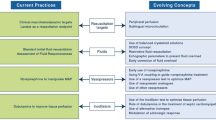Abstract
Objectives
To determine the effect of pretreatment with polyenylphosphatidylcholine (lecithin, PPC) on plasma levels of tumor necrosis factor (TNF)-α, interleukin (IL)-6, IL-10, total nitrite/nitrate (NOx), and tissue levels of superoxide dismutase (SOD) and malondialdehyde (MDA) in septic rats.
Design
Prospective, randomized, controlled animal study.
Setting
University laboratory.
Subjects
Forty-five Spraque-Dawley rats were divided into three groups: group C, sham-operated; group S, sepsis; and group P, sepsis pretreated with PPC.
Interventions
Rats were made septic by cecal ligation and puncture (CLP). Group P rats were treated with PPC (100 mg/day orally) for 10 days before sepsis. Twenty-four hours later CLP, plasma concentrations of TNF-α, IL-6 and IL-10 and plasma levels of NOx were measured. SOD and MDA were determined in liver, lung and heart homogenates.
Measurements and main results
All rats in group P survived during the 24-h observation time after CLP, whereas survival rate in group S was 66.7% (10/15; P<0.05). PPC significantly reduced plasma levels of TNF-α (P=0.006), IL-6 (P=0.007), IL-10 (P=0.016), NOx (P<0.001), and tissue levels of MDA (P<0.001) in group P with respect to in group S. Tissue levels of SOD significantly increased in group P when compared with group S (P<0.001).
Conclusions
These results show that PPC pretreatment exerts cumulative effects in decreasing the levels of cytokines, NOx, and tissue MDA concentrations, with a concomitant increase in survival in septic rats. Lecithin therapy may be a useful adjuvant therapy in controlling of the excessive production of the inflammatory cytokines in patients with severe sepsis.
Descriptor
SIRS/sepsis, experimental studies


Similar content being viewed by others
References
Heyland DK, Samis A (2003) Does immunonutrition in patients with sepsis do more harm than good? Intensive Care Med 26:669–671
Clouva-Molyvdas P, Peck MD, Alexander JW (1992) Short-term dietary lipid manipulation does not affect survival in two models of murine sepsis. J Parenter Enteral Nutr 16:343–347
Bower RH, Cerra FB, Bershadsky B, Licari JJ, Hoyt DB, Jensen GL, Van Buren CT, Rothkopf MM, Daly JM, Adelsberg BR (1995) Early enteral administration of a formula (Impact) supplemented with arginine, nucleotides and fish oil in intensive care unit patients: results of a multicenter, prospective, randomized, clinical trial. Crit Care Med 23:436–449
Vollmar B, Baurer C, Menger MD (2002) n-3 Polyunsaturated fatty acid-enriched diet does not protect from liver injury but attenuates mortality rate in a rat model of systemic endotoxemia. Crit Care Med 30:1091–1098
Mayer K, Gokorsch S, Fegbeutel C, Hattar K, Rosseau S, Walmrath D, Seeger W, Grimminger F (2003) Parenteral nutrition with fish oil modulates cytokine response in patients with sepsis. Am J Respir Crit Care Med 167:1321–1328
Stoffel W, Darr W, Assmann G (1978) Pleomorphic functions of highly unsaturated phospholipids in biological membranes and serum lipoproteins. Med Welt 26:124–131
Navder KP, Baraona E, Lieber CS (2000) Dilinoleoylphosphatidylcholine protects human low density lipoproteins against oxidation. Atherosclerosis 152:89–95
Cao Q, Mak KM, Lieber CS (2002) Dilinoleoylphosphatidylcholine decreases LPS-induced TNF-α generation in Kuppfer cells of ethanol-fed rats: respective roles of MAPKs and NF-κB. Biochem Biophys Res Commun 294:849–853
Baker CC, Chaudry IH, Gaines HO, Baue AE (1983) Evaluation of factors affecting mortality rate after sepsis in a murine cecal ligation and puncture model. Surgery 94:331–335
Green LC, Wagner DA, Glogowski J, Skipper PL, Wishnok JS, Tannenbaum SR (1982) Analysis of nitrate, nitrite, and [15N]nitrate in biological fluids. Anal Biochem 126:131–138
Sun Y, Oberley LW, Li Y (1988) A simple method for clinical assay of superoxide dismutase. Clin Chem 34:497–500
Uchiyama M, Mihora M (1977) Determination of malonaldehyde precursor in tissues by thiobarbituric acid test. Biochim Biophys Acta 20:271–278
Walley KR, Lukacs NW, Standiford TJ, Strieter RM, Kunkel SL (1996) Balance of inflammatory cytokines related to severity and mortality murine sepsis. Infect Immun 64:4733–4738
Damas P, Ledoux D, Nys M, Vrindts Y, De Groote D, Franchimont P, Lamy M (1992) Cytokine serum level during sepsis in human IL-6 as a marker of severity. Ann Surg 215:356–362
Barnes P, Karin M (1997) Nuclear factor-κB: a potential transcription factor in chronic inflammatory diseases. N Engl J Med 336:1066–1071
Gomez-jimenez J, Salgado A, Mourelle M, Martin MC, Segura RM, Peracaula R, Moncada S (1995)l-Arginine: nitric oxide pathway in endotoxemia and human septic shock. Crit Care Med 23:253–258
Macdonald J, Galley HF, Webster NR (2003) Oxidative stress and gene expression in sepsis. Br J Anaesth 90:221–232
Lieber CS (1997) Treatment alcoholic liver disease. In: Brechot C, Lebrec D, Poupon R (eds) New treatment in hepatology. Paris, pp 89–125
Ha YL, Storkson J, Pariza MW (1990) Inhibition of benzo(a)pyrene-induced mouse forestomach neoplasia by conjugated dienoic derivates of linoleic acid. Cancer Res 50:1097–1101
Acknowledgement
This study was supported by grants from the Scientific Research Foundation of İnönü University (2002/04).
Author information
Authors and Affiliations
Corresponding author
Rights and permissions
About this article
Cite this article
Demirbilek, S., Ersoy, M.Ö., Demirbilek, S. et al. Effects of polyenylphosphatidylcholine on cytokines, nitrite/nitrate levels, antioxidant activity and lipid peroxidation in rats with sepsis. Intensive Care Med 30, 1974–1978 (2004). https://doi.org/10.1007/s00134-004-2234-4
Received:
Accepted:
Published:
Issue Date:
DOI: https://doi.org/10.1007/s00134-004-2234-4




